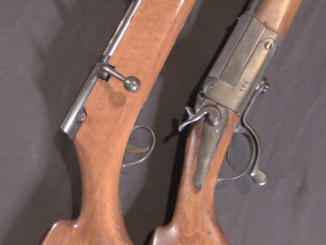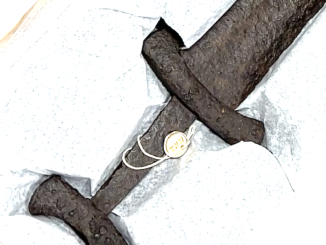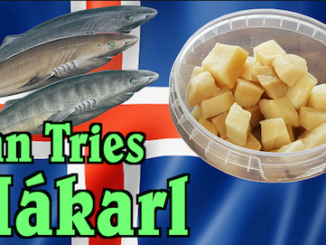See Dr. Crawford’s video here:
“Men of Terror: A Comprehensive Analysis of Viking Combat” on Amazon by Reynir Óskarson and William Short
My helmet was generously provided by Grimfrost.
I have been privileged to be part of an original research project in collaboration with Dr. Jackson Crawford studying the early medieval origins of firearms in Europe. Studying manuscripts in the National Museum of Iceland, Dr. Crawford unearthed records of events that point to the accidental discovery of gunpowder during the Settlement Period on Iceland. Further study has revealed that the “atgeirr” references in some Icelandic sagas is, in fact, a long-forgotten early firearm. Consider, from Njal’s Saga:
“Hallgrímr had an atgeirr which he had ordered enchanted with dark magic, so that no weapon could kill him except for it. The enchantment also caused men to know right away when the weapon was used to kill someone, because the weapon would sing before it killed, so that it was heard far away. This was the great magic in the weapon.”
With the help of two craftsmen I recreated what we believe an atgeirr would have looked like, and took it out to the range. Lo and behold, it worked even better than we could have anticipated! It was truly an honor to be a part of this groundbreaking research.




Okay. I guess this is cool enough. But if Ian wants to truly impress me, he needs to take the “atgeirr” to a BUG match.
This would actually be period correct. The Norse primary weapon would still be a sword, or axe, or spear. An “atgeirr” would be for limited use to supplement the primary weapon. Thus a true “backup gun”.
So far the research on this topic has been all “scholarly”. You know, someone spending weeks in the dusty basement of an archive reading through hard to read old manuscripts. But what was the true field combat usage of the weapon?
To sort this out, I therefore propose the creation of a Norse Brutality match. This would be set up a bit different than most Brutality matches. There would be a single stage where competitors would do one cycle of the stage each. This is followed by additional repetitions of the stage by all competitor.
There would be two stations in the stage, spaced 40 yards or so apart. At the starting point would be a table holding a battle axe and the “atgeirr” with its ammunition. The stage is run in this manner.
A competitor drinks a horn of mead. This is necessary for historical accuracy to properly simulate the actual “state” of the Norse warriors when they went into battle. The competitor picks up the axe, runs to the second station and hacks of the head of a dummy. The competitor then runs back to the first station, loads the “atgeirr” and fires at a target.
So how is the winner of the match decided? While honorable mention can be given to the competitors that run the repetitions in the shortest time, or is the most accurate with the “atgeirr”, or who makes the cleanest cut when dismembering the dummy, this would not be the true determination of a winner. The winner is the last man standing. The repetitions are repeated as many times as needed to test who has true Norse stamina.
This would be a very good way to truly understand the use of the “atgeirr” in hard combat.
Truly one of the most imaginative and elaborate April Fools pranks I’ve yet seen. Particularly the participation of everyone else involved…
Perhaps we could get a “making of” thing, outlining it all?
I keep thinking the same thing… is it? It’s incredibly elaborate if it is.
Mutton for supper!
Great topic. The hand cannon (Gonne) was pretty wide spread throughout Scandinavia Europe as well as the far east by the mid 1300s. I have a few reproductions. They can certainly be aimed and are minute of man at close ranges.
Does the Icelandic version of BATF recognize this as ‘once a hand implement, always a hand implement’?
We await the translation of the earlier work “Eric the Eyebrowless.’
OK, April Fool, but still there’s some food for thought here.
First of all, in 1065 AD (a year before the Norman Conquest of England) a Chinese emperor nationalized all production of saltpeter in China. You only do that if it’s a strategic material. Ergo, something like black powder was probably in use in China by that time.
Second, the idea of black powder almost certainly got to Europe from China over the Silk Route. How can we tell? Several early European black powder formulae included things like arsenic and dried and powdered dung. These did nothing for ignition efficiency obviously, but they were common ingredients in early Chinese “thunderclap” bomb fillings, clay “grenades” thrown by hand or catapult.
When the black powder in them exploded, the arsenic or dung dust would be dispersed, resulting in a sternutating effect; a lung injurant. (NB; the British army developed a device for doing the same thing with arsenic dust in WW1; a Top Secret weapon that was not used due to the Armistice.)
It is reasonable to conclude that their presence in early European formulations was the result of the European artificers copying Chinese recipes and not understanding the difference between a propellant powder formula and one for a bomb filling.
What this does is lead back to the Icelanders. They could well have heard of this sort of thing (after all they’d been raiding England and sailing down rivers to Constantinople for three centuries by that time), and have been in an “if they can do it, so can we” mood.
I would point out that if they had smiths who could make tools like shovel heads with sockets to fit onto handles, they could certainly make the sort of “gun barrel” shown here.
As for saltpeter, never mind shark meat. There are caves in Iceland where you find calcium nitrate encrusting the walls, just as you do in Turkey. And in the latter territory, one early name for saltpeter was “the flower of the stone of Assos”; “Assos” being the old name of Behram, a town noted for its funerary caves. Calcium nitrate formed on the walls from natural deposits there, so it is reasonable to assume there were probably caves in Iceland which also had sufficient deposits. Ones that could be “mined” for the critical ingredient in making things go “bang”.
Just food for thought, as I said. And no, I’m not fooling.
clear ether
eon
Presumably, there were huge deposits of bird droppings along the coast of Iceland, as well…
I thought of that. As far as I know, bats (Europe’s favorite little saltpeter producers) of various types have never been native to Iceland. But there are something like 370 different species of birds that are native to Iceland, and some of them, like puffins and terns, are the kind who congregate in large-economy-sized rookeries.
That equals a lot of bird s#!t.
cheers
eon
I thought guano would have been a more plausible source of nitrates but they just had to work in the arctic shark thing into the narrative. Made for a better prank.
Ive never heard of BP made out of calcium nitrate. Is it even possible ?
Another thing to add is there are even sources in Han dynasty China around 2000 years ago of possible gunpowder use in China. Albeit the source is mentioning three chemicals dancing violently it does not go into specifics of the composition
The main problem I have with this video is the majority of audience won’t check the date to see it’s an April fools joke
I have some books that I think you would be interested in, I would be glad to donate to your library. They are “History of the World War” by Frank H. Simonds, I only have the first five volumes. It is contemporary, written while the war was ongoing. Many photos and drawings. Also “Travels in North America during 1834-5-6” volumes 1&2 by The Hon. Charles Augustus Murray a first edition published in 1839. If you do not already have these, I will send them to what ever mailing address you provide. I am 73 and I do not know anyone you would give them a better home.
Not to make too fine a point but because we all really enjoy your videos….PLEASE do not pour your black powder directly from the 1lb container directly into the barrel. If there was a smoldering ember in the barrel/chamber it will detonate the powder being poured in and the canister you are holding. Best case scenario you would have to change your name to Ian No Hand.
I take it that Ian is not into black powder shooting. Maybe some lessons are in order. Other wise “Forgotten Weapons” becomes “Forgotten Ian”.
Best 4/1/2023 of all times! I’m still just wishing it was real it was sold so well.
“(…)wishing it was real(…)”
This reminded me about device named First shalt thou take out the Holy Pin. Then, shalt thou count to three. No more. No less. Three shalt be the number thou shalt count, and the number of the counting shall be three. Four shalt thou not count, nor either count thou two, excepting that thou then proceed to three. Five is right out. Once the number three, being the third number, be reached, then, lobbest thou thy Holy Hand Grenade of Antioch towards thy foe, who, being naughty in My sight, shall snuff it. by Monty Python in 1975 and similar real found much latter https://www.timesofisrael.com/was-monty-pythons-holy-hand-grenade-of-antioch-fact-crusader-era-explosive-found/
I’d be inclined to think they were more probably using a local variant, not of black powder, but of Greek Fire. Naph as it was known in Arabic-speaking lands was a 7th Century AD Byzantine invention that survived well into the gunpowder era there.
The presence of P plus “fatty acids” would strongly indicate that this was an incendiary mixture. The P would be included to render it self-igniting on exposure to air, i.e. when the clay pot shattered on impact.
It’s worth noting that while the Chinese used incendiaries and flamethrowers run on “fierce fire oil” (light fractions of petroleum, basically low-octane gasoline) as far back as the 6th Century AD, they never discovered Greek Fire with its self-igniting properties until they learned of it from European traders via the Silk Route in the mid-13th Century AD.
It seems to be the one deadly chemical composition they didn’t invent themselves.
clear ether
eon
Hello,
My complaints for yet another very well made video. Here is the interesting part I found – “Aatiyar” is the word you mentioned at 07:40, which according to you means a firearm. In Hindi, Urdu and almost all Indian languages we have a word called “ Hatiyar” which describes weapon in general! I guess it has same origins as the language you just mentioned. I guess we are more connected than we are diverse. You can ask any Indian, aur Arabic guys as to what
“Atiyar” means, and he/she will instantly reply “ weapon”. I isn’t it cool!!!
This will go down with “The Gospel of John” 19:11 as one of the one of the best shitposts Ian has ever created. No. in fact, given that the hoax was not just Ian but a large group of respected collaborators/pranksters and that there were two posts involving a large team of intelligent and fun-loving “history people” I think that this is a Saga deserving of illuminated text on sheepskin. Fin brill everyone for doing it!
And yet another link “corroborating” the find:
https://www.youtube.com/watch?v=A2OQV4MOOBg
The staff holding the match is known as a linstock https://en.wikipedia.org/wiki/Linstock
Cone of Arc needs to see this. His Fake Tank Friday postings on Youtube must be seen to be believed. The really sad part are the number of people – for some strange reason, including many wehraboos – believe these vehicles actually existed. https://www.bing.com/videos/search?q=fake+tank+friday&qpvt=fake+tank+friday&view=detail&mid=C17DB1C7D9CD441F7BA7C17DB1C7D9CD441F7BA7&&FORM=VRDGAR&ru=%2Fvideos%2Fsearch%3Fq%3Dfake%2Btank%2Bfriday%26qpvt%3Dfake%2Btank%2Bfriday%26FORM%3DVDRE
Looked at the Fake Tanks. It is sad that some of them did not really exist
Knowledge continues to march forward, like a Norseman.
King Gustavus Wasa of Sweden did enjoy shooting his enemies into the air during the 1500s. He ordered the graveyards to be dug up as a source of salpeter ….
I was totally fooled. Once the irritation passed, I have to say…good job.